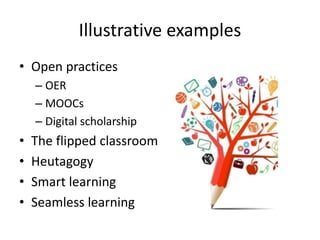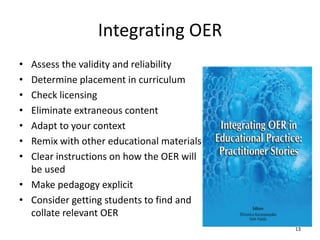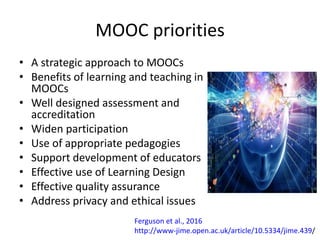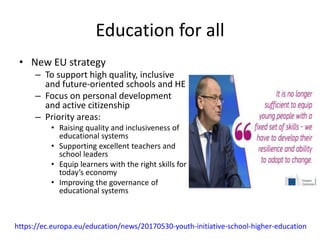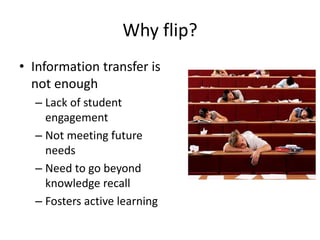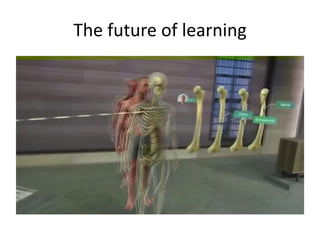Conole keynote sligo
- 1. The future of learning: addressing supercomplexity and harnessing technologies Gráinne Conole EdTech Conference, Sligo, Ireland 1st June 2017 National Teaching Fellow 2012 Ascilite fellow 2012EDEN fellow 2013
- 3. Outline • The future of learning – Future education scenarios – Refocusing teaching and learning – Competencies – Digital literacies • Supercomplexity • Related concepts and discourses • Illustrative examples – Open practices – The flipped classroom – Heutagogy – Smart learning – Seamless learning
- 4. Future educational scenarios • Interaction with digital technologies will be more pervasive, seamless and invisible – Personal devices • Technology embedded and distributed in most objects – Intelligent environments • Your environment adapts to you and know everything about you – The network • Blanket wireless connectivity – Significant storage capability – Enhanced security https://www.nfer.ac.uk/publications/FUTL54/FUTL54.pdf
- 5. Refocusing teaching and learning • What counts is less what individuals know • More what individuals can do • Preparing students for a changing and unknown future • Increasing importance of flexibility, adaptability and self-reliance • Need to change and reinvent identities • Characteristics of learning – It’s about transformation – Knowledge is information transformed – Personal, social, distributed, ubiquitous, flexible, dynamic and complex https://www.nfer.ac.uk/publications/FUTL54/FUTL54.pdf
- 6. The future of learning • Competences – Critical thinking – Problem solving – Team work – Communication – Collaboration – Meta cognition – Networking – Creativity – Reflexivity – Flexible http://www.rockyview.ab.ca/21stC/learning/competencies
- 7. The future of learning • Digital literacies – Evaluation – Transmedia navigation – Multitasking – Distributed cognition – Networking – Visualisation – Metaphors – Collective intelligence – Play – Digital identity management Jenkins, JISC
- 8. Researching through the generations: reflecting on the past, present and future
- 9. Supercomplexity • The state of affairs we find ourselves in… – Uncertainty – Unpredictability – Challenge – Change • Impossible to resolve by traditional means • Teaching learners for an unknown future Barnett
- 10. Related concepts and discourses • An ecosystem of learning – Educators, learners, technologies, resources – Boundaries more permeable – New kinds of agency in learning (Barron, 2006) – Learner-centred ecology of resources (Luckin, 2010) • Affordances – All "action possibilities" latent in the environment, objectively measurable and independent of the individual's ability to recognize them, but always in relation to the actor and therefore dependent on their capabilities (Gibson, 1977) – Co-evolution of tools and individuals • Distributed cognition (Salomon, 2003) • Rhizomatic learning (Cormier, 2008) • Digital literacies and identities http://e4innovation.com/?p=935
- 11. Illustrative examples • Open practices – OER – MOOCs – Digital scholarship • The flipped classroom • Heutagogy • Smart learning • Seamless learning
- 12. Open practices • Increase of free resources and expertise – via webinars, blogs, open repositories and journals, and social media • Digital technologies enable more open practices • Educational practices that are concerned with and promote equity and openness • Range of practices around create, use and management of OER • Results in a change in practice • Connectedness, trust and innovation • Increasing importance of OER and MOOCs • Challenging traditional business models
- 13. Integrating OER • Assess the validity and reliability • Determine placement in curriculum • Check licensing • Eliminate extraneous content • Adapt to your context • Remix with other educational materials • Clear instructions on how the OER will be used • Make pedagogy explicit • Consider getting students to find and collate relevant OER 13
- 14. OER Case Study • OER at the Open University UK – Research • OER hub conducts research on the impact of OER – Community • GO-GN develops a global community of OER PhD students – Content • OpenLearn releases thousands of hours of open licensed materials – International • TESSA and TESS-India use locally developed OER to aid teacher education
- 15. Open Online, Flexible & Technology- Enhanced Models project • OU UK and FIBS commissioned by ICDE • Identifying new business models – Looking at content development, content delivery, recognition and certification • Business model components (Boer and Lindgren, 2015) – Products and services – Markets – Communication Channels – Value chain – Competitive advantage – Networks – Sustainability http://www.surveymonkey.co.uk/r/OOFATGENERAL
- 16. Principles • Identify exemplary distance provision models • Focus: – Content (subject knowledge, support and learning analytics) – Delivery (place, pace and timing) – Recognition (of learning achievements)
- 17. Mohsen Saadatmand A new ecology for learning
- 18. MOOC timeline Powell & Yuan (2015).
- 20. An Open Networked Learning Ecology Saadatamand, 2017
- 21. MOOC drivers • Cost • Technology solution • Learner demands • Ways to educate the many • Institutional branding • Shared services • Collaboration • Exploring online pedagogies • Innovation • Toe in the water…
- 22. MOOC a contested discourse • Social inclusion • Quality • Accreditation • Support • Disruptive • Transformative • Connectivist • Personalised
- 23. MOOC priorities • A strategic approach to MOOCs • Benefits of learning and teaching in MOOCs • Well designed assessment and accreditation • Widen participation • Use of appropriate pedagogies • Support development of educators • Effective use of Learning Design • Effective quality assurance • Address privacy and ethical issues Ferguson et al., 2016 http://www-jime.open.ac.uk/article/10.5334/jime.439/
- 24. MOOC strategies • Clarity of relevance/purpose, for – Institution – Academics – Participants • Clear evaluation plan • Design support • Alignment to institutional mission • Sustainability • Quality assurance • Learner support • Assessment and accreditation mechanisms – Badges – Certificates of participation/completion – Peer feedback – Routes into formal educational offerings
- 25. Designing effective MOOCs • Design steps – the 7 C’s of Learning Design – Conceptualise – Create – Communicate – Collaborate – Consider – Combine – Consolidate • Tips and hints – Keep short – Keep video below 10 minutes – Video or podcasts? – Indicate learning hours – Clear learning outcomes – Encourage reflection and dialogue – Simple text and instructions – Core and extension activities – Structured learning pathways: • Connect, activate, consolidate • Present, apply, review – Use learning analytics to: • Evaluate • Improve • Support http://e4innovation.com/?p=800
- 26. Dimension Characteristics Context Open Degree to which the MOOC is open Massive How large the MOOC is Diversity The diversity of the learners Learning Use of multimedia Extent of use of rich multimedia Degree of communication Amount of communication incorporated Degree of collaboration Amount of collaboration incorporated Amount of reflection Ways in which reflection is encouraged Learning pathway Degree to which the learning pathway is supported Quality assurance Degree of quality assurance Certification Mechanisms for accreditation Formal learning Feed into formal learning offerings Autonomy Degree of learner autonomy A taxonomy of MOOCs http://e4innovation.com/?p=727
- 27. Recognising non-formal learning • Analysed practices for assessment and recognition of non-formal learning • Barriers: – Online seen as lower value – Lack of guidance on recognition options – Cost of recognition – Need to unbundle learning provision http://publications.jrc.ec.europa.eu/repository/bitstream/JRC96968/lfna27660enn.pdf
- 28. Digital scholarship • Scholarship: four aspects (Boyer) – Discovery – Integration – Application – Teaching • Digital scholarship – Use of digital evidence and research to achieve scholarly and research goals • Digital scholarship – Digital – Networked – Open • Technologies are transforming practice http://blog.edtechie.net/ Weller (2011)
- 29. Education for all • New EU strategy – To support high quality, inclusive and future-oriented schools and HE – Focus on personal development and active citizenship – Priority areas: • Raising quality and inclusiveness of educational systems • Supporting excellent teachers and school leaders • Equip learners with the right skills for today’s economy • Improving the governance of educational systems https://ec.europa.eu/education/news/20170530-youth-initiative-school-higher-education
- 30. The flipped classroom • Students engage with content before the class – Video, podcasts etc. • Teacher poses questions about the content • Classroom is student- centred and active https://www.youtube.com/watch?v=26pxh_qMppE&feature=youtu.be
- 31. Why flip? • Information transfer is not enough – Lack of student engagement – Not meeting future needs – Need to go beyond knowledge recall – Fosters active learning
- 32. The traditional classroom • Teacher as gatekeeper, giving information, deciding what is important • Content delivered during class • Students assimilate the learning outside of the class • Students as content consumers
- 33. The flipped classroom • Students view content before class • Focus in class on active learning • More student centred • Teacher as facilitator • Fosters student engagement • Independent study plus face-to-face interaction
- 34. Benefits for the teacher • Can see students at work interacting with others • Frees time to help students during class • Identify struggling students • Provide more personalised attention
- 35. Benefits for the students • Shift from passive consumer of information to active learning • Can work at their own pace • Have more control of learning whilst watch videos, can stop and re-watch or skim through • More peer interaction • More engaging and motivating
- 36. Heutagogy • Study of self- determined learning • Knowing how to learn • Learners are autonomous • Web 2.0 affordances – Learner-generated content – Self directedness http://leolearning.com/2014/03/heutagogy-designing-for-self-directed-learners/ Blaschke, L.M. (2012)
- 37. Smart learning • Learning across formal and informal contexts • Personalised, adaptive and flexible • Learner controlled • Smart devices and intelligent technologies • Ubiquitous devices such as the Internet of things and wearable technologies • Intelligent technologies – Learning analytics, cloud computing – How learning data can be captured, analysed, and use to improve learning and teaching • Designing technology-enhanced learning spaces – Spaces for Knowledge Generation (SKG) project 19-20 May 2017, St Petersburg
- 38. Seamless learning • Across time and locations • Ubiquitous access to resources • Physical and virtual • Multiple devices • Integrating different approaches to learning and teaching
- 39. A day made of glass
- 40. Educating for supercomplexity • Rigorous approaches to learning design • Harnessing the power of learning analytics • Implementing innovative pedagogies that: – Support self-reliance, resilience, agility, adaptability – Encourage meta-cognition and reflection – Utilize the affordances of digital technologies – Enable technology-enhance learning spaces – Develop competencies to deal with an unknown future
- 41. Useful resources • Learning Design – Larnaca Declaration – JIME special issue • Learning analytics – SOLAR – Handbook of learning analytics • Learning theories – HoTEL learning theories – Pedagogies for the future – Bridging learning theories and TEL
- 42. Questions for the future • How prepared are we for the massive changes digital technologies are likely to enable? • Are our future scenarios for education based on assumptions from humanity, society and technology that may not be valid in the future? • How can we help shape the developments of technology to enhanced human development?
- 43. The future of learning
- 44. Are we living in a simulation?
- 45. g.conole@gmail.com Website: e4innovation.co.uk BlogL e4innovation.com Twitter: @gconole http://www.slideshare.net/GrainneConole










